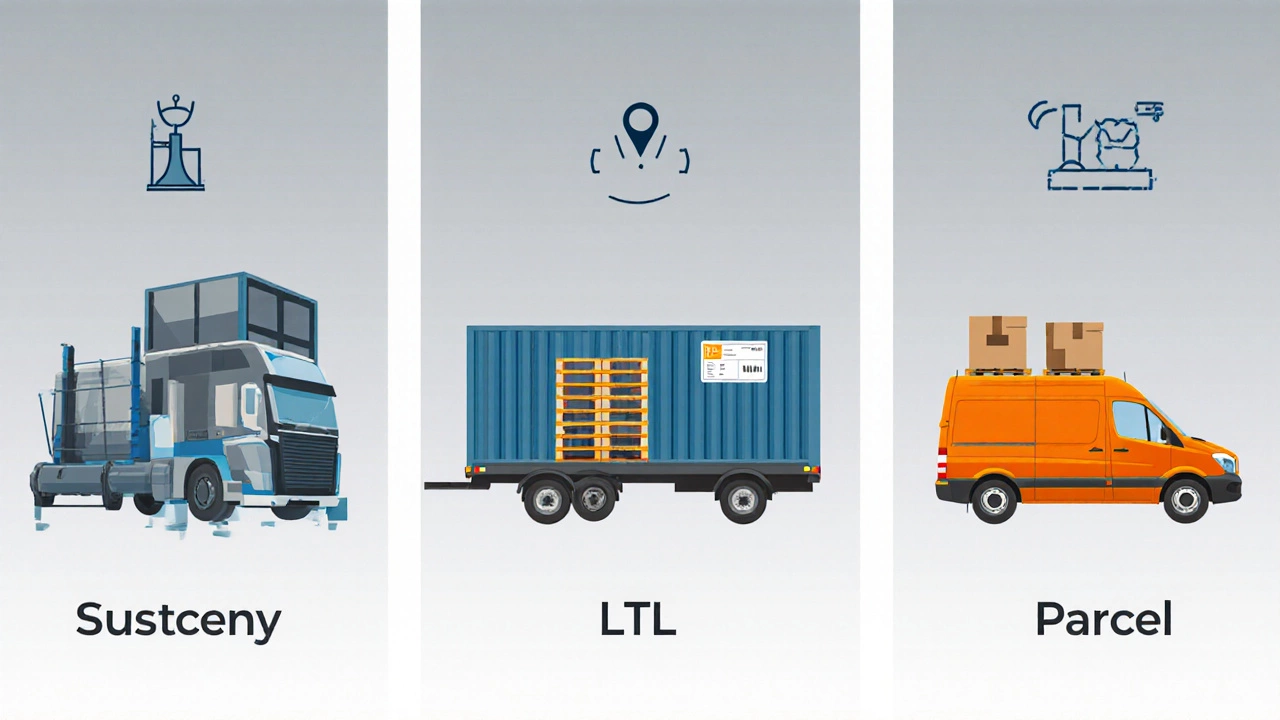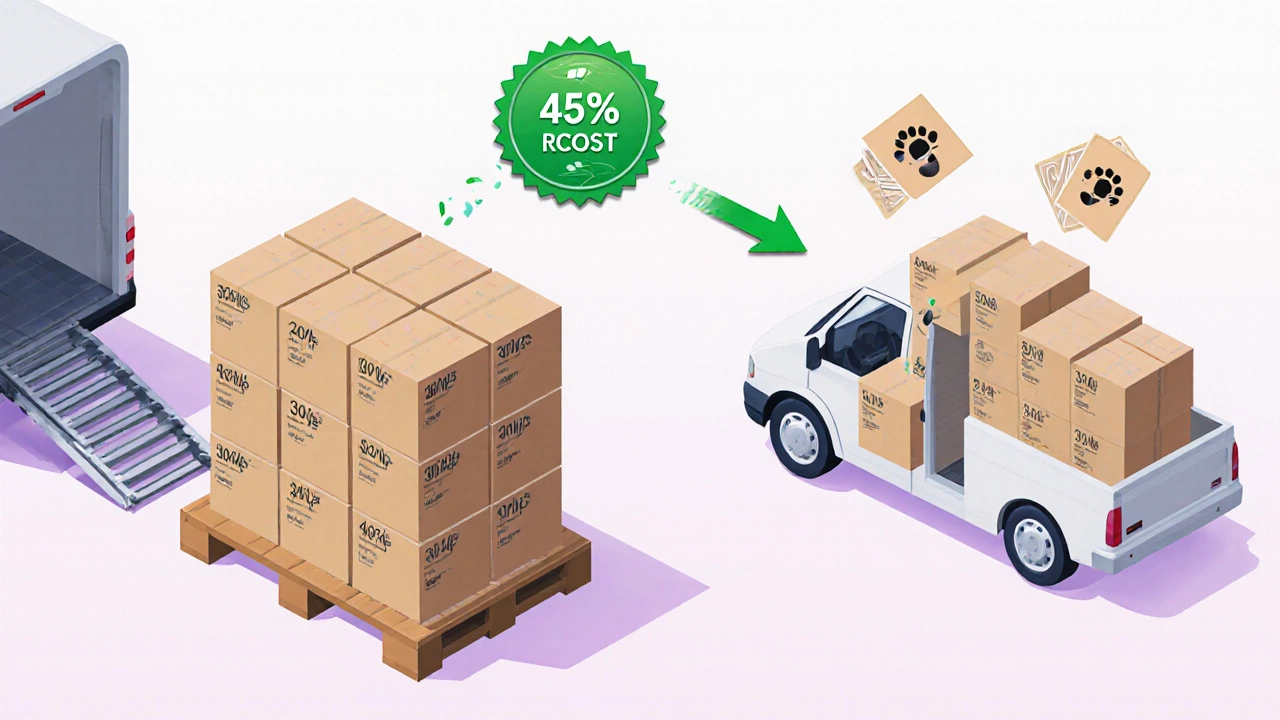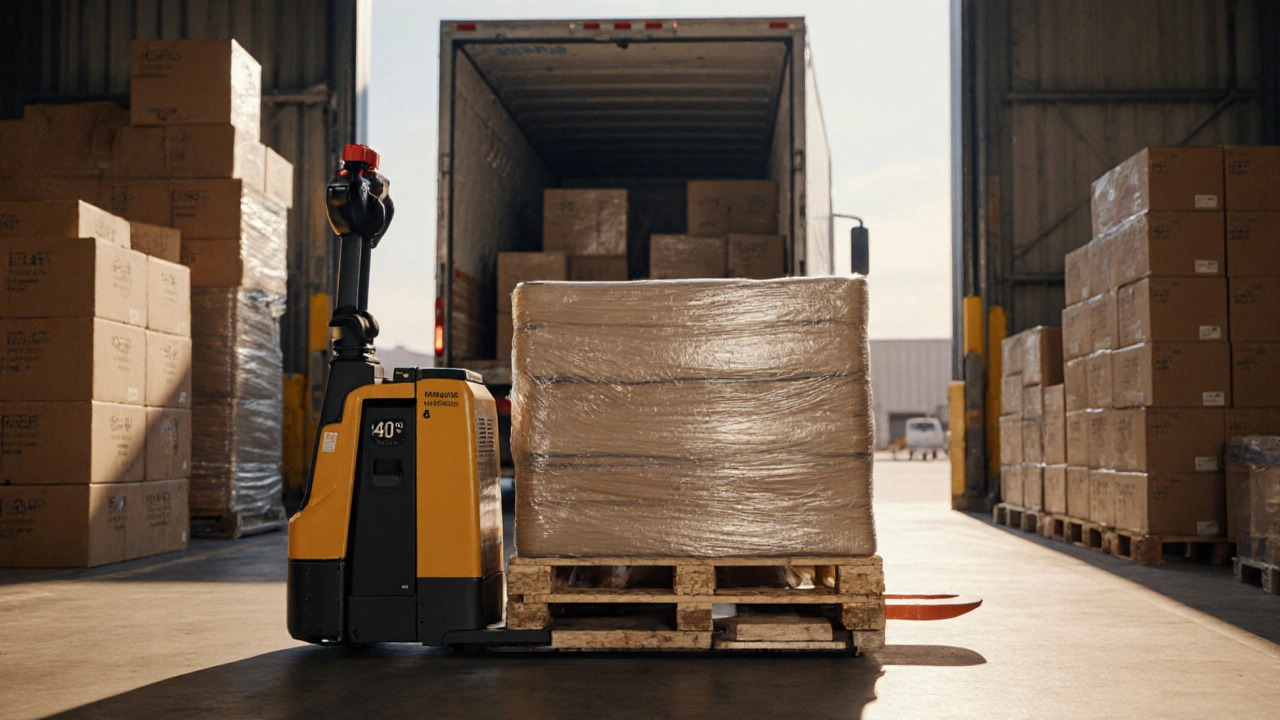Pallet Shipping Cost Calculator
Your Shipment Details
Results
Pallet shipping is a freight option where goods are loaded onto a wooden or plastic platform that standardizes handling, stacking, and transport. By consolidating multiple boxes onto one pallet, shippers can often reduce handling fees and secure lower freight rates compared to individual parcel shipments. But does it always translate into cheaper overall costs? This guide breaks down the pricing mechanics, compares pallet rates to other common methods, and shows you when a pallet truly saves money.
How Pallet Shipping Works
When you choose pallet shipping, you first decide on the standard pallet size-most U.S. shippers use the 48" x 40" (48" × 40") pallet, while Europe favors the 1200 mm × 800 mm Euro pallet. After loading, the pallet is wrapped in film to keep items stable, then placed on a trailer, truck, or container. The carrier treats the pallet as a single unit for handling, which cuts down on labor and equipment usage.
What Drives Pallet Shipping Cost
Three main factors shape the final price:
- Freight class - a rating from 50 to 500 that reflects density, stowability, handling, and liability. Higher‑class items (lighter, bulkier) cost more per pound.
- Weight and volume - carriers calculate both actual weight and dimensional weight. The larger of the two determines the billable weight.
- Distance and lane - long‑haul routes and high‑traffic lanes often have lower per‑mile rates due to economies of scale.
Additional surcharges-fuel, lift‑gate, residential delivery-can affect the total, but they apply to pallet, LTL, and parcel shipments alike.
Cost Comparison: Pallet vs. LTL vs. Parcel
| Metric | Pallet Shipping | LTL (Less‑Than‑Truckload) | Parcel (e.g., UPS, FedEx) |
|---|---|---|---|
| Base rate per 100 lb | $45‑$55 | $60‑$75 | $80‑$120 |
| Fuel surcharge (average %) | 12% | 12% | 15% |
| Lift‑gate surcharge | $30 (optional) | $30 (optional) | Not applicable |
| Typical handling time | 1‑2 days (regional) | 2‑4 days (regional) | 1‑3 days (express) |
| Ideal shipment size | 150‑2,000 lb or multiple cartons | 100‑2,500 lb (mixed pallets) | Up to 70 lb per package |
The table shows why pallets often win on a per‑pound basis, especially when you can fill the pallet to a decent density. However, the savings shrink if you ship light, high‑volume items that bump into a higher freight class.
When Pallet Shipping Saves Money
Use pallets if your shipment meets any of these criteria:
- Weight above 150 lb - the higher the weight, the lower the per‑pound cost compared to parcel rates.
- Stable, stackable items - boxes that can be tightly packed reduce the freight class to a lower (cheaper) range.
- Multiple cartons - consolidating 10‑20 small boxes onto one platform eliminates repeated handling fees.
- Business‑to‑business (B2B) routes - carriers often reserve the best lane discounts for freight customers.
Conversely, a single lightweight item (e.g., a 5‑lb gadget) will almost always be cheaper as a parcel because pallet minimums and lift‑gate surcharges add unnecessary overhead.

Tips to Reduce Pallet Shipping Expenses
- Measure density accurately. Use the formula Weight ÷ (Length × Width × Height) to determine the correct freight class.
- Negotiate a contract rate with a freight forwarder who can batch your pallets across multiple lanes.
- Consider “partial pallet” services. Some carriers accept under‑filled pallets for a modest extra fee, still cheaper than parcel for 200‑400 lb totals.
- Use reusable plastic pallets when possible; they’re lighter, which can lower the billable weight.
- Plan shipments to avoid residential deliveries. Door‑to‑door pallet drops to commercial addresses typically skip the residential surcharge.
Checklist: Should You Ship by Pallet?
- Is the total weight ≥ 150 lb?
- Can the items be securely stacked on a standard pallet?
- Do you have at least 8‑10 cartons (or equivalent volume) to fill the pallet?
- Is the destination a commercial address (no extra residential fee)?
- Do you have a reliable freight partner to consolidate shipments?
If you answer “yes” to most of these, pallet shipping is likely the cheaper route.
Common Misconceptions About Pallet Costs
Myth 1: Pallet shipping is always cheaper. Not true - light, high‑volume items can push you into a higher freight class, erasing the per‑pound advantage.
Myth 2: You must fill the pallet completely. While a full pallet maximizes savings, many carriers accept “partial pallets” with a small premium that still beats parcel for moderate loads.
Myth 3: All pallets are the same. The 48" × 40" wood pallet is common in North America, but Euro pallets, bulk pallets, and plastic pallets each have different weight and size attributes that affect cost.

Real‑World Example
A small e‑commerce brand needs to send 12 boxes of 30 lb each (total 360 lb) from Chicago to Dallas. Shipping each box as a parcel would cost $35 per box, totaling $420 plus fuel surcharges. Packing the boxes on a standard pallet yields a freight class 150 rate of $50 per 100 lb, plus a $30 lift‑gate fee (optional). Calculation:
- Base rate: 360 lb ÷ 100 lb × $50 = $180
- Fuel surcharge (12%): $21.60
- Lift‑gate (optional): $30
- Total: $231.60
Result: A 45% cost reduction compared to parcel shipping. The brand also benefits from fewer handling touches, reducing damage risk.
Future Trends Impacting Pallet Shipping Costs
Automation in warehouses is driving tighter pallet stacking, which lowers freight class for many shipments. Additionally, green initiatives are encouraging carriers to prioritize full‑pallet loads to reduce carbon emissions, potentially leading to incentive discounts for shippers who consolidate.
Quick Takeaways
- Pallet shipping usually beats parcel on a per‑pound basis for loads over 150 lb.
- Accurate freight class calculation is the biggest cost lever.
- Use a freight forwarder and consider partial‑pallet options to maximize savings.
When does pallet shipping become more expensive than parcel?
If the shipment weighs less than 150 lb, has a high freight class (light but bulky), or requires a residential delivery, the added pallet minimums and surcharges can push the total above a standard parcel rate.
Can I ship a partially filled pallet?
Yes. Many LTL carriers offer a “partial pallet” service that charges a small surcharge (typically $15‑$30) but still provides lower per‑pound costs than individual parcels for loads between 100‑400 lb.
How does freight class affect pallet pricing?
Freight class is based on density, stowability, handling, and liability. A lower class (e.g., 70) means higher density and cheaper rates per pound, while a higher class (e.g., 300) can increase the billable weight, making pallets less economical.
Should I always use a wood pallet?
Wood pallets are cheap and widely accepted, but they add weight. If you’re shipping light items over long distances, a lightweight plastic pallet can lower the billable weight and improve cost efficiency.
What role does a freight forwarder play in pallet cost savings?
A freight forwarder consolidates multiple shippers’ pallets, fills trucks more efficiently, and can negotiate lane discounts. Their expertise in classifying freight correctly often trims 5‑15% off the base rate.


